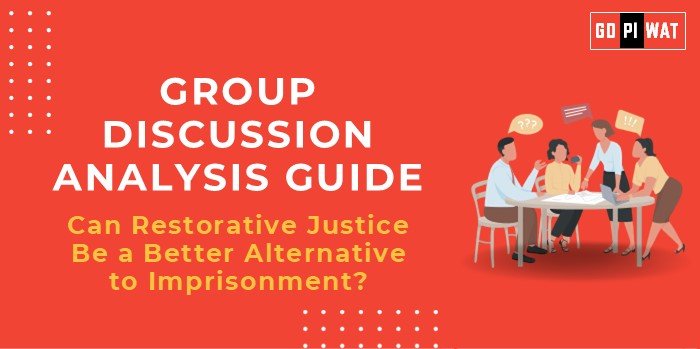📋 Group Discussion (GD) Analysis Guide: Can Restorative Justice Be a Better Alternative to Imprisonment?
🌐 Introduction to Restorative Justice
- 📜 Opening Context: Restorative justice is an alternative criminal justice approach that emphasizes repairing harm rather than solely punishing offenders. It focuses on reconciliation between victims, offenders, and the community, contrasting sharply with traditional imprisonment models.
- 📖 Background: Originating in indigenous practices, restorative justice has gained attention globally for its potential to reduce recidivism and foster community healing. Modern examples include New Zealand’s restorative justice courts and Canada’s indigenous sentencing circles.
📊 Quick Facts and Key Statistics
- 🌍 Global Recidivism Reduction: Restorative justice programs have reduced reoffending rates by up to 27% (UNODC, 2023).
- 📈 Victim Satisfaction: 85% of victims reported being satisfied with restorative justice outcomes in UK trials (MOJ, 2022).
- 💰 Cost Efficiency: Restorative programs cost 20-50% less than incarceration, as per studies in the Netherlands (2023).
- 🤝 Community Trust: Countries using restorative approaches report higher public trust in justice systems (European Forum for Restorative Justice, 2023).
👥 Stakeholders and Their Roles
- 🏛️ Government: Implements restorative programs, legislates, and monitors outcomes.
- ⚖️ Judiciary: Integrates restorative processes within sentencing frameworks.
- 🌐 Community Organizations: Facilitate reconciliation meetings and support both victims and offenders.
- 🗣️ Victims: Key participants in the healing process, enabling offender accountability.
- 🔄 Offenders: Engage in meaningful restitution to victims and communities.
🏆 Achievements and Challenges
✨ Achievements
- 📉 Reduced Reoffending: Netherlands reports a 30% drop in repeat offenses post-restorative interventions.
- 💡 Victim Empowerment: Canadian programs show a 70% improvement in victims’ emotional recovery.
- 💰 Cost Savings: New Zealand’s model saves $1.5 billion annually in incarceration costs.
- 🌍 Cultural Appropriateness: Indigenous practices integrated into restorative justice have promoted cultural healing.
⚠️ Challenges
- 📈 Scalability: Implementation remains limited to pilot projects in most countries.
- 🛑 Victim Resistance: Some victims may prefer traditional punitive measures.
- ❌ Complex Cases: Serious crimes like homicide pose challenges in achieving restorative outcomes.
Global Comparisons:
• Success: New Zealand leads with mandatory restorative practices for youth offenses.
• Challenges: The US struggles with integrating restorative justice in a punitive-focused system.
📢 Structured Arguments for Discussion
- 💬 Supporting Stance: “Restorative justice humanizes the criminal justice system, reduces recidivism, and fosters community healing, proving more sustainable than imprisonment.”
- 🗣️ Opposing Stance: “For serious offenses, restorative justice may fail to deliver the deterrence and accountability achieved through imprisonment.”
- ⚖️ Balanced Perspective: “While restorative justice offers numerous benefits, its effectiveness depends on crime severity, cultural adaptability, and public acceptance.”
📈 Effective Discussion Approaches
- 💡 Opening Approaches:
- Statistical Insight: “Restorative programs cut reoffending rates by nearly 27%, showing promise over incarceration.”
- Global Case Study: “New Zealand’s restorative justice courts provide a benchmark for reducing recidivism and incarceration costs.”
- 💡 Counter-Argument Handling:
- “While serious crimes pose challenges for restorative justice, hybrid systems combining incarceration and restorative practices can offer a balanced solution.”
📊 Strategic Analysis: SWOT Framework
Strengths
- 📉 Reduced recidivism.
- 🤝 Victim satisfaction.
- 💰 Cost efficiency.
Weaknesses
- ❌ Scalability issues.
- 🛑 Victim resistance.
Opportunities
- 🌍 Global adoption.
- ⚖️ Hybrid justice systems.
Threats
- ⚠️ Public skepticism.
- 📉 Misuse in serious offenses.
🎓 Connecting with B-School Applications
- 💡 Real-World Applications:
- Policies addressing criminal justice reform.
- Corporate conflict resolution frameworks.
- 💡 Sample Interview Questions:
- “How can restorative justice principles apply to corporate governance?”
- “What challenges exist in scaling restorative justice globally?”
- 💡 Insights for Students: Offers interdisciplinary research themes in law, psychology, and public policy.


